
The family Sciomyzidae belongs to the typical flies (Brachycera) of the order Diptera. They are commonly called marsh flies, and in some cases snail-killing flies due to the food of their larvae.

The Calliphoridae are a family of insects in the order Diptera, with almost 1,900 known species. The maggot larvae, often used as fishing bait, are known as gentles. The family is known to be polyphyletic, but much remains disputed regarding proper treatment of the constituent taxa, some of which are occasionally accorded family status.
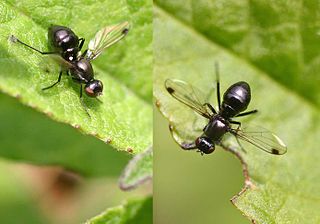
The Sepsidae are a family of flies, commonly called the black scavenger flies or ensign flies. Over 300 species are described worldwide. They are usually found around dung or decaying plant and animal material. Many species resemble ants, having a "waist" and glossy black body. Many Sepsidae have a curious wing-waving habit made more apparent by dark patches at the wing end.

André Jean Baptiste Robineau-Desvoidy was a French physician and entomologist specialising in the study of Diptera (flies) and to some extent of the Coleoptera (beetles).

The Anthomyiidae are a large and diverse family of Muscoidea flies. Most look rather like small houseflies. Most species are drab grey to black. Many Pegomya are yellow, and some members of the genera Anthomyia and Eutrichota are patterned in black-and-white or black-and-silvery-grey. Most are difficult to identify, apart from a few groups such as the kelp flies that are conspicuous on beaches.
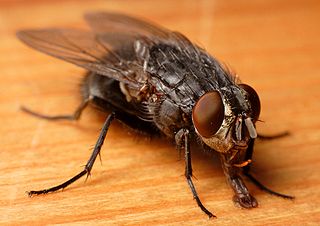
Calliphora is a genus of blow flies, also known as bottle flies, found in most parts of the world, with the highest diversity in Australia. The most widespread species in North America area Calliphora livida, C. vicina, and C. vomitoria.
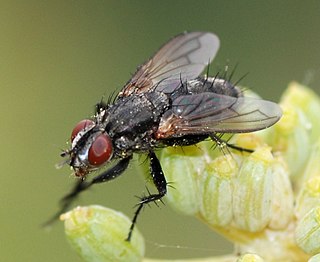
Rhinophorinae is a subfamily of flies (Diptera), commonly known as Woodlouse Flies, found in all zoogeographic regions except Oceania, but mainly in the Palaearctic and Afrotropical regions.

Lucilia is a genus of blow flies in the family Calliphoridae. Various species in this genus are commonly known as green bottle flies.

The Richardiidae are a family of Diptera in the superfamily Tephritoidea.

Strauzia longipennis is a large species of tephritid fruit fly known by the common name sunflower maggot. It is a minor pest whose larvae mine stems of sunflowers. Damage from larval feeding on spongy tissue is usually light. The larvae do not damage the flower head or seeds, although those of other fruit fly species do so.

Urophora cardui or the Canada thistle gall fly is a fruit fly which, contrary to its common name, is indigenous to Central Europe from the United Kingdom east to near the Crimea, and from Sweden south to the Mediterranean.
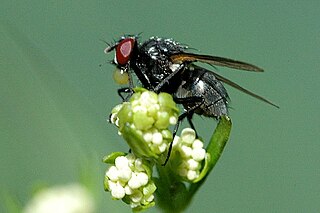
Hydrotaea is a genus of insects in the housefly family, Muscidae. They occur in most regions of the world but are more populous in warmer climates. They are often found on feces in summer months, and are therefore generally found in close proximity to livestock. Among the 130 known species in this genus, one of the most commonly recognized is the dump fly.
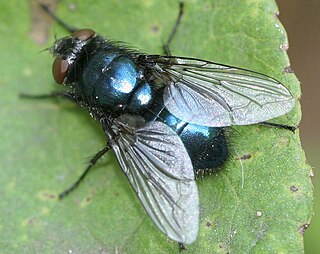
Protophormia terraenovae is commonly called northern blowfly, blue-bottle fly or blue-assed fly. It is distinguished by its deep blue coloration and large size and is an important species throughout the Northern Hemisphere. This fly is notable for its economic effect as a myiasis pest of livestock and its antibiotic benefits in maggot therapy. Also of interest is P. terraenovae’s importance in forensic investigations: because of their temperature-dependent development and their prominent presence on corpses, the larvae of this species are useful in minimum post-mortem interval (mPMI) determination.

Exoristinae is a subfamily of flies in the family Tachinidae. Most species are parasitoids of caterpillars.

Exorista larvarum is a Palaearctic species of fly in the family Tachinidae.

Rivellia is a genus of signal flies. There are at least 140 described species in Rivellia.

Phytomyza ranunculi is a species of fly in the family Agromyzidae. It is found in the Palearctic.

Platystoma lugubre is a species of fly in the family Platystomatidae.

Aciura coryli is a species of tephritid or fruit flies in the genus Aciura of the family Tephritidae.

Chromatomyia scolopendri is a species of leaf-mining fly in the family Agromyzidae, of the order Diptera. The larva mine the leaves of ferns. It was described by Jean-Baptiste Robineau-Desvoidy in 1851 and is found in Europe.




















